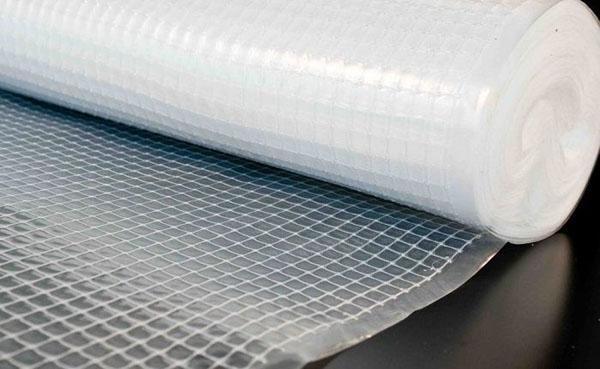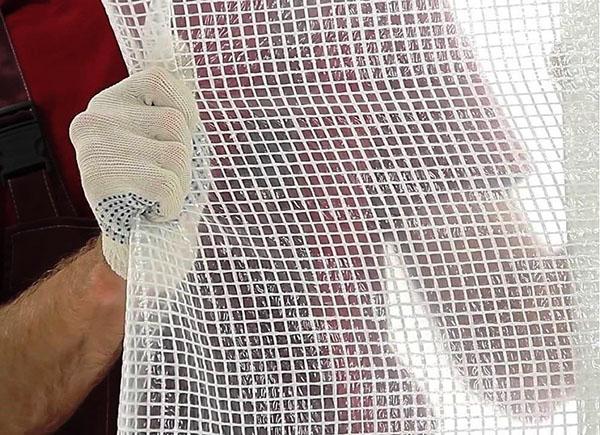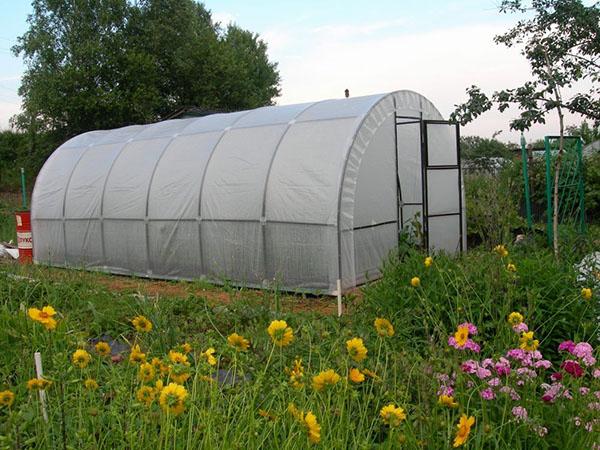The use of reinforced film at the summer cottage

The use of reinforced film in horticulture has been known for a long time. This unique material has many positive properties. It is characterized by high strength, reliability, resistance to possible damage, and also protects plants from atmospheric manifestations (snow, hail, rain, frost).
What is reinforced film

The material consists of two layers of polyethylene and a frame made of mesh. During the use of such a film, the entire load is distributed over mesh, and the canvas itself, thus, becomes tear-resistant and does not deformed. You can spoil the material only by puncturing it, and then, with this damage, the affected area will be minimal and can be restored.
Reinforced sheeting can be permanently stretched over the greenhouse if your land is located in an area with a warm climate.
Features of reinforced film:
- overload capacity (80%);
- can withstand temperatures up to +900FROM;
- possesses strength (impacts of a mechanical nature are not terrible).
The properties of the reinforced canvas largely depend on additives, used in the production process. Depending on the composition, the film is divided for: polypropylene, twisted, fiberglass.
Material advantages:
- long-term operation;
- due to the layers it has high strength;
- the coating can be used for several years;
- large selection of sizes;
- does not deform;
- resistant to manifestations of atmospheric precipitation;
- ecological cleanliness.
An important feature of such a canvas is the absence of the composition of harmful additives. Therefore, it is used even at high temperatures.
Application of reinforced film in agriculture

The main purpose of reinforced film for agriculture is the creation of greenhouses, greenhouses, awnings and shelters.
To create greenhouses, a film is used that is breathable (there are very small holes in each cell). Due to this, air and water enter the greenhouse.
Reinforced film is also used for insulation of already available greenhouses. It is enough to make a cover out of it. The film can be used and as a protective layer for the facade of the building: this way the wall will be protected from atmospheric manifestations, and the room inside will keep warm.
Due to its unique properties, the material is used in any industries where something needs to be covered and insulated. For example, harvest packaging, shelter of equipment and equipment.
The quality and durability of the film depends on its density. For greenhouses suitable canvases with indicators of 110-200 g / m2. They will not only it will reliably protect plants from precipitation, wind, but also provide inside the structure favorable conditions for their development.
By making the right choice of material for the greenhouse, you will ensure full growth of plants. A film with a light stabilization additive will last longer than usual.
To make it easier for yourself to install your greenhouse, opt for a reinforced film with ring fastening.
Installation work on creating a greenhouse and greenhouse

There are practically no works related to the reinforced film differ from the work of creating a greenhouse based on conventional material. Frame greenhouses are covered with a cover and secured with nails or staples. Often people use clamps as fasteners. Some reinforced films are already have special fasteners in the form of rings, so working with them will be simple and fast.
The type of construction of a greenhouse or greenhouse will affect sequence and time of performance of installation work on sheathing with foil. Any the summer resident knows how to properly attach the film to the greenhouse frame. But, there are also frameless greenhouses, which require some features.
Frameless and framed

A greenhouse like this is the fastest way to hide plants. To create it, a plot of land with just planted plants, covered with a reinforced film, and fixed with pegs in the corners or stones. In this case, it is recommended to choose the usual canvas, since it is denser and less prone to damage.
Often to create frameless greenhouse use a greenhouse, which is already not suitable for these purposes. Do not throw away the used film, because individual, whole parts of it can be reused for small frameless greenhouses.
A greenhouse can also be built on the basis of a frame structure. For this along the perimeter of the earth, wooden pegs are fixed on which film.
Frame greenhouses and greenhouses

Such designs are reliable due to the use metal base. The reinforced film is pulled onto the frame, fixing wire, staples or nails. If the base of the greenhouse is made of wood, then fix the canvas follows with slats, nails and boards.
The cellular type of the frame allows the film to show all the positive characteristics that are associated with strength:
- Indeed, during the tension of the web, the load is evenly distributed between the reinforced threads.
- The material is convenient in that even if its surface is damaged by something sharp, the structure will not disintegrate. The hole will not extend further than to the edge of the mesh of the reinforced material.
Correct installation begins with an assessment of the condition of the frame future greenhouse or greenhouse. If the base is uneven, has bulges, is damaged, the film attachment should be postponed. Repair the frame first and then paint it. It is better if it is light, so as not to attract much heat. The film is fixed to the base using self-tapping screws.
Polyethylene reinforced film is a reliable material, easy to use and durable in the process. When creating greenhouses from film, you don't need to spend a lot of time at work, and also have certain skills. A person who knows the basics of construction and repair will be able to cope with the task quickly and independently.